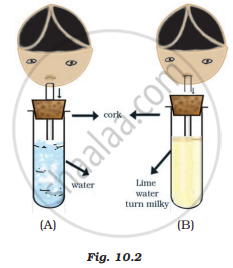Advertisements
Advertisements
प्रश्न
Given below is an overall chemical reaction of a certain process:
C6H12O6→LacticAcid+2ATP+Heat energy
Is this reaction applicable to animals or to plants or to both animals and plants?
उत्तर
This reaction is applicable to animals only.
APPEARS IN
संबंधित प्रश्न
Carbon dioxide enters into the leaves through tiny pores present on the surface of the leaf called _________.
(a) chlorophyll
(b) chloroplast
(c) stomata
(d) epidermis
The breakdown of pyruvate to give carbon dioxide, water, and energy takes place in ______.
What are the differences between aerobic and anaerobic respiration? Name some organisms that use the anaerobic mode of respiration.
Define breathing. State the differences between breathing and respiration.
State the three common features of all the respiratory organs like skin, gills and lungs.
What is meant by aquatic animals and terrestrial animals?
Why do fishes die when taken out of water?
Explain how, it would benefit deep sea divers if humans also had gills.
What is the function of the respiratory system?
Give the main points of difference between respiration in plants and respiration in animals.
Which of the following is correct for the process of anaerobic respiration?
| Carbon dioxide always produced | A lot of energy released | |
| (a) | No | Yes |
| (b) | No | No |
| (c) | Yes | No |
| (d) | Yes | Yes |
Which of the following is known as the energy currency of the cells in biology?
During the respiration of an organism A, 1 molecule of glucose produces 2 ATP molecules whereas in the respiration of another organism B, 1 molecule of glucose produces 38 ATP molecules.
(a) Which organism is undergoing aerobic respiration?
(b) Which organism is undergoing anaerobic respiration?
(c) Which type of organism, A or B, can convert glucose into alcohol?
(d) Name one organism which behaves like A.
(e) Name two organisms which behave like B.
A, B and C are three living organisms. The organism A is a unicellullar fungus which can live without air. It is used in the commercial production of an organic compound P from molasses. The organism B is a unicellular animal which lives in water and feeds and moves by using pseudopodia. It breathes through an organelle Q. The organism C is a tiny animal which acts as a carrier of malarial parasite. It breathes and respires through a kind of tiny holes R and air-tubes S in its body.
(a) What are organisms (i) A (ii) B, and (iii) C?
(b) Name (i) P (ii) Q (iii) R, and (iv) S.
(c) Which organism/organisms undergo aerobic respiration?
(d) Which organism/organisms undergo anaerobic respiration?
An organism X having breathing organs A lives on land. When organism X goes underwater, it cannot survive for a long time unless carrying an oxygen cylinder. On the other hand, the organism Y having breathing organs B always lives in water and if taken out of the water, it dies after a short while. A third organism Z having breathing organs C and D which lives on the banks of ponds, lakes, and rivers can survive on land as well as in water equally well.
(a) What could organism X be? Name the breathing organs A.
(b) What could organism Y be? Name the breathing organs B.
(c) What could organism Z be? Name the breathing organs C and D.
(d) Out of X, Y, and Z, which organism is (i) amphibian, (ii) aquatic, and (iii)
terrestrial?
What happens to the glucose which enters the nephron tubule alongwith the filtrate?
Veins and arteries carry blood. Which of these carry blood back to the heart?
Name the body structure concerned with the given functional activity:
Protects the lungs from mechanical injury
Given below is an example of certain structure and its special functional activity:
"Kidney and excretion".
Fill in the blanks on a similar pattern.
Alveoli and _____________.
Given below is an example of certain structure and its special functional activity:
"Kidney and excretion".
Fill in the blanks on a similar pattern.
'C' shaped cartilage rings and ____________.
State one function of the following:
Mitochondria
Air that enters through the nose passes into this tube.
____________ refers to a biochemical process of oxidation of organic compounds in an orderly manner for the liberation of chemical energy in the form of ATP.
How does aerobic respiration differ from anaerobic respiration?
Mark the following statement as True or False. Correct the false statement.
Exhaled air has more percentage of CO2 than inhaled air
On a very cold morning, Boojho and Paheli were talking with each other as they walked down to their school. They observed that the air coming out of their mouth looked like smoke. They were amused and wondered how it happened. Help them find the answer.
Observe Figure 10.2 carefully and answer the following questions.

- Which process is being tested in the activity?
- What is the result of the activity? Give reasons.
List the similarities between aerobic and anaerobic respiration.
Visit a doctor. Find out about artificial respiration. Ask the doctor:
- When does a person need artificial respiration?
- Does the person need to be kept on artificial respiration temporarily or permanently?
- From where can the person get supply of oxygen for artificial respiration?
